Tomorrow we’ll have the first Supermoon of the year – the Worm Moon! Do you know where the name comes from? Here’s a short story I wrote (meant to be told orally). I hope you can share it with your children, or at least enjoy its message.
*****
Look up! What do you notice? Did you observe that the full moon is larger than usual? We call it a Supermoon, and your eyes aren’t deceiving you… The moon IS larger than usual because it’s closer than usual, and that’s because the moon’s orbit around the Earth isn’t perfectly circular – it’s elliptical.
Every Supermoon has a special name, and today I want to tell you where this one’s name comes from. Let’s go back five or even ten thousand years ago, to when the native people of this country lived in harmony with nature. During Winter, the humans who lived between Lake Superior and New England in what is now the United States hunted, wore animal skins, made fires, and took shelter from the snow. They waited patiently for Spring to come, but they didn’t have calendars like we do. Instead, they observed nature to know when the seasons were changing.
Every year, around this time, they noticed tiny, dark brown pellets on the cold, slowly-thawing ground. These pellets – we call them castings – were a clue for them, a message from nature that warmer weather was ahead. When these castings appeared, so did something else: robins – grey birds with bright orange breast feathers. The robins weren’t eating the castings, because castings is just a fancy word for poop! They were preying on the animals who left the castings. Can you guess which animals the birds were eating?
Yes, worms! Earthworms! The appearance of worm castings told humans that warmer weather was on its way, because the ground was now soft enough for the worms to move through it. The presence of worms also indicated that the land was almost ready for planting, since these animals do the important work of aerating the soil and their castings help plants absorb more nutrients.
Earthworms came to signify the end of winter and the approach of the planting season, which meant fresh food and survival for another year. And thus, this Supermoon became known as the Worm Moon.
Other human groups have given it different names, like Crow Moon, Crust Moon, and Sap Moon. You can investigate the stories behind these names and let us know what you discover. But for now, when we look up at the Worm Moon, we can think back to those patient and resourceful people who didn’t need paper calendars, because they lived in harmony with the Earth.





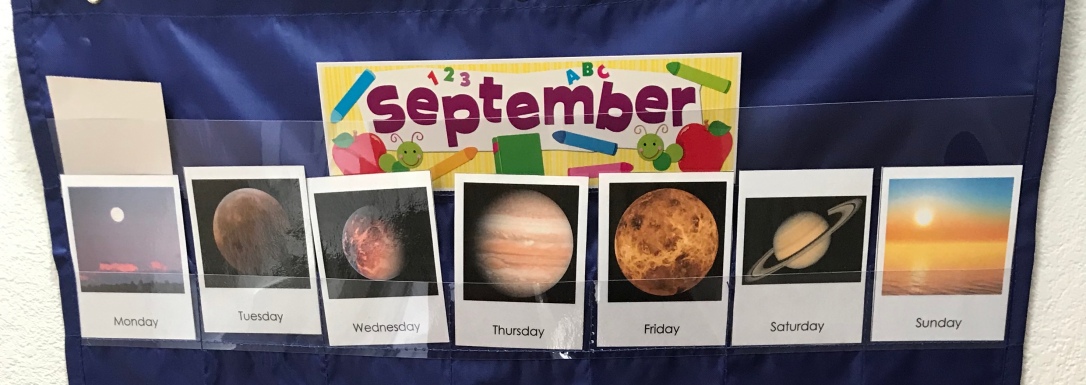

 They’re great for a homeschool environment because they don’t take up any shelf space. Their initial purpose is to help the child first
They’re great for a homeschool environment because they don’t take up any shelf space. Their initial purpose is to help the child first  Find the number: Ask the child to set out the hundred chain with the corresponding arrows, while you cut up a few blank paper arrows (cut little rectangles and trim the corners to make arrows). Write a number on the arrow (any number between 1 and 99) and have the child place the arrow on the corresponding bead. If you notice mistakes, you can either let it be for now (and encourage more practice) or invite the child to count from the nearest tens-arrow (e.g. if the paper arrow says “26” and it’s in the wrong spot, invite the child to count linearly from the “20” arrow).
Find the number: Ask the child to set out the hundred chain with the corresponding arrows, while you cut up a few blank paper arrows (cut little rectangles and trim the corners to make arrows). Write a number on the arrow (any number between 1 and 99) and have the child place the arrow on the corresponding bead. If you notice mistakes, you can either let it be for now (and encourage more practice) or invite the child to count from the nearest tens-arrow (e.g. if the paper arrow says “26” and it’s in the wrong spot, invite the child to count linearly from the “20” arrow). can present a new challenge by having them find the missing number in a number sequence. The first few times you do this, you can use the regular arrows for any chain and hide one behind your back. Ask the child to lay out the arrows and tell you which one is missing. (e.g. The child lays out 5, 10, 20, 25 and tells you that 15 is missing.)
can present a new challenge by having them find the missing number in a number sequence. The first few times you do this, you can use the regular arrows for any chain and hide one behind your back. Ask the child to lay out the arrows and tell you which one is missing. (e.g. The child lays out 5, 10, 20, 25 and tells you that 15 is missing.)
 Polygons: The chains provide a fun exploration of shapes, from triangle to decagon. Have the child carry all the chains on a tray to a large rug and ask her to make a closed shape with each chain imagining that the center was pressing out evenly on all sides. Then ask her how many sides each shape has. If you have a Geometry Cabinet, ask her to find the corresponding shape from the cabinet and put it inside or next to the bead shapes. The child can write on a slip of paper the number of sides each shape has, and then you can give the names. You can do a three-period lesson with a Primary child, and you can make an etymology chart with an Elementary child. The child can also build the shapes around each other, with the square surrounding the triangle, the pentagon surrounding the square, etc.
Polygons: The chains provide a fun exploration of shapes, from triangle to decagon. Have the child carry all the chains on a tray to a large rug and ask her to make a closed shape with each chain imagining that the center was pressing out evenly on all sides. Then ask her how many sides each shape has. If you have a Geometry Cabinet, ask her to find the corresponding shape from the cabinet and put it inside or next to the bead shapes. The child can write on a slip of paper the number of sides each shape has, and then you can give the names. You can do a three-period lesson with a Primary child, and you can make an etymology chart with an Elementary child. The child can also build the shapes around each other, with the square surrounding the triangle, the pentagon surrounding the square, etc.




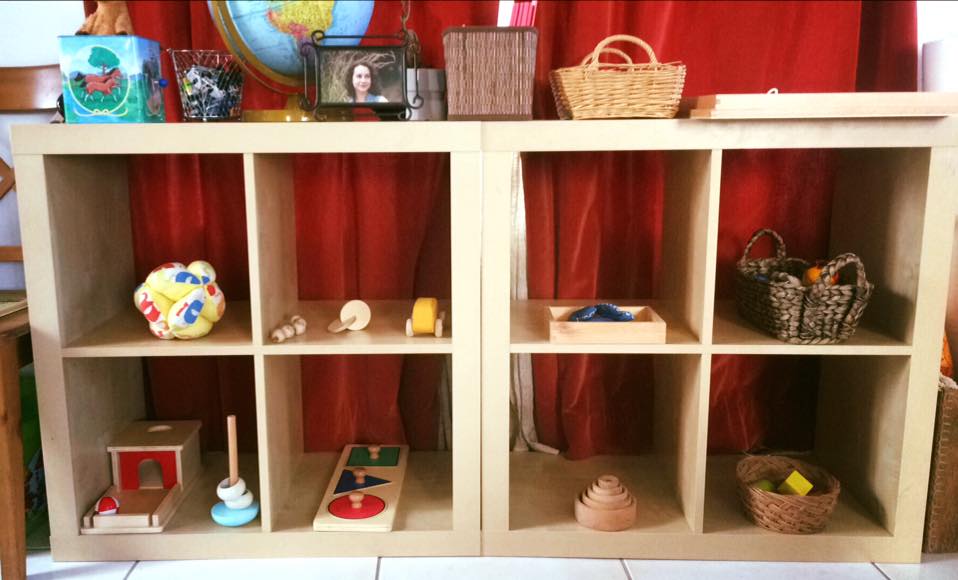
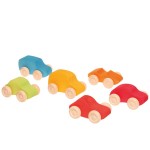 They are sturdy and lots of fun for toddlers to crash! For Nadia I rotate one at a time, but when Zachary was a toddler he enjoyed racing them with mommy and daddy. You can find them
They are sturdy and lots of fun for toddlers to crash! For Nadia I rotate one at a time, but when Zachary was a toddler he enjoyed racing them with mommy and daddy. You can find them 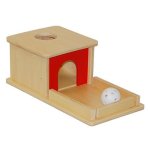 plastic ball it came with for a sturdier wooden ball because it has a more pleasing sound when it hits the bottom of the box.
plastic ball it came with for a sturdier wooden ball because it has a more pleasing sound when it hits the bottom of the box. 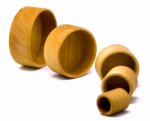 ny, and they are one of her favorite toys. We had a three-year old friend come over to play, and she had a great time stacking them, so it’s a toy with plenty of growth potential! The wood is beautiful and very high quality. You can
ny, and they are one of her favorite toys. We had a three-year old friend come over to play, and she had a great time stacking them, so it’s a toy with plenty of growth potential! The wood is beautiful and very high quality. You can 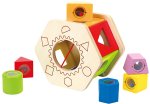 She’s not old enough to understand sorting yet, but she likes how the shapes rattle (they have little balls inside). Once she’s old enough to sort, she’ll already be familiar with the shapes!
She’s not old enough to understand sorting yet, but she likes how the shapes rattle (they have little balls inside). Once she’s old enough to sort, she’ll already be familiar with the shapes! swiveling base that allows you to see the South Pole without having to flip the base over. It has raised topography and up-to-date political geography. The reviews are mixed on Amazon because sometimes the meridians don’t line up, but ours is defect-free and it’s been a HUGE hit with Zachary.
swiveling base that allows you to see the South Pole without having to flip the base over. It has raised topography and up-to-date political geography. The reviews are mixed on Amazon because sometimes the meridians don’t line up, but ours is defect-free and it’s been a HUGE hit with Zachary.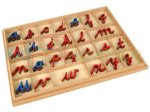 are made out of wood, they are sturdy and attractive, and they have a nicer weight than the more expensive plastic ones from Nienhuis that most AMI classrooms have. Plus, each compartment has its corresponding letter printed on it, for easy clean-up (another thing that more expensive plastic model don’t have). For a homeschooling family, I think this is the ideal Moveable Alphabet.
are made out of wood, they are sturdy and attractive, and they have a nicer weight than the more expensive plastic ones from Nienhuis that most AMI classrooms have. Plus, each compartment has its corresponding letter printed on it, for easy clean-up (another thing that more expensive plastic model don’t have). For a homeschooling family, I think this is the ideal Moveable Alphabet.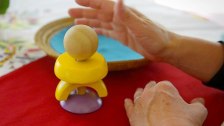 If you’ve been following the
If you’ve been following the  We hunted for some cotton, six glass jars, a handful of beans, masking tape and a Sharpie. I showed him how to separate the cotton and prepare one jar – cotton layer, three beans, and another cotton layer. Then he prepared all the rest on his own. I asked him what sounds were in the words “agua” and “pipi” (he’s bilingual), and carefully wrote the words in cursive as he watched. And then, because he had just used the bathroom, I invited him to drink a big glass of water.
We hunted for some cotton, six glass jars, a handful of beans, masking tape and a Sharpie. I showed him how to separate the cotton and prepare one jar – cotton layer, three beans, and another cotton layer. Then he prepared all the rest on his own. I asked him what sounds were in the words “agua” and “pipi” (he’s bilingual), and carefully wrote the words in cursive as he watched. And then, because he had just used the bathroom, I invited him to drink a big glass of water.